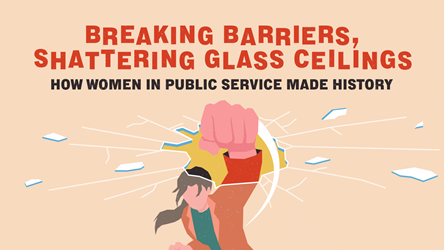Bringing Personalised Services Closer To Older Folk
.jpg)
In the movie, The Intern, a senior citizen joins an internship programme after growing bored with retirement. A box office hit, the movie also gave unexpected inspiration to Central Provident Fund Board (CPFB) staff, who were trying to find better ways to help seniors with their retirement planning.
When Singaporeans turn 55 years old, “many often feel confused, afraid and lost regarding the changes to their accounts”, says Mr Wong Yan Jun, Acting Group Director, Customer Relations Group, CPF.
To address this, the CPFB launched one-to-one, faceto- face CPF Retirement Planning Sessions for seniors, and received positive feedback. Building on this, it partnered the People’s Association (PA) to tap on their Golden Work Series, a programme training retired senior citizens for parttime employment. The CPFB enlisted the Series participants as “ambassadors” for its CPF Retirement Planning Service sessions.
The retirees, having experienced the decision-making process for their CPF savings when they turned 55, could better relate to other seniors and clearly explain to them and their family members about what to expect.
Together with these ambassadors, the CPFB staff would answer questions about retirement planning using personalised information and clear visual aids, such as large infographics with bite-size information.
Taking inspiration from pop-up retail stalls, the CPFB also created mobile service centres to bring retirement planning and other CPF services closer to residents. Again, they tapped the PA’s extensive network – this time, its community clubs.
“Our objective was to make it easy for Singaporeans, especially the elderly, to access our services,” says Mr Wong. “Instead of waiting for CPF members [to come to us], we are proactively reaching out to more of them.”
For CPF member Mr Huang Junda, the short queues and efficient service at the CPFB’s mobile service centre in Ci Yuan Community Club made visiting a pleasant experience. “[The staff] was very knowledgeable and friendly, and helped answer all my queries about my parents’ CPF,” he says.
By December 2016, more than 7,000 CPF members had visited the mobile service centres set up at five community clubs. Of those who attended the retirement planning sessions, more than 95% surveyed said they would recommend the service to their friends or family.
Ultimately, the project’s success hinged on having “good people” to run the mobile service centres and help deliver the retirement planning service, says Mr Wong. He also credits his senior management, who gave his team “time and flexibility to create, test and refine” the delivery of the programme.
Besides the customer service officers who “adopted an open, positive mindset to incorporate new methods” to help members, the centres’ back-end staff also contributed to the smooth running of the programme, he notes.
A bonus, adds Mr Wong, is that the retiree ambassadors say they are now themselves better acquainted with CPF policies, having learned information that they can share with friends and family.
Taking inspiration from pop-up retail stalls, the CPFB also created mobile service centres to bring retirement planning and other CPF services closer to residents.
No time to see the doctor?
As older Singaporeans work longer to attain greater financial security for retirement, visiting the doctor for the healthcare they need has become a luxury for some.
Through interviews, focus groups and surveys, the Health Promotion Board (HPB) found that workers 40 years old and above often have trouble finding time to see the doctor for treatments or engage in follow-up lifestyle programmes. This is particularly so for those in the transport sector, who have busy and irregular schedules. In addition, the 2010 National Health Survey showed that Singaporeans aged 40 to 69 had a higher prevalence of chronic disease compared to the general population.
As part of the Ministry of Health’s Action Plan for Successful Ageing, the HPB decided to bring healthcare to these older workers, through customised programmes held where the workers tend to congregate, and at times most convenient for them – even if that meant waking up at odd hours to match the workers’ schedules.
To reach out to bus captains, for example, the HPB would be at bus depots at 4am so that drivers could participate in health screenings before their shifts started. For taxi drivers, the HPB had a “Check Car, Check Body” programme at taxi service centres where drivers waiting for their cars to be serviced could get health checks or coaching.
The HPB team would also “set up shop” in unconventional places like makeshift containers or storage areas. “We had to go beyond our comfort zone,” says Ms Prema Govindan, Deputy Director, Workplace Health & Outreach at the HPB.
Having the right mindset, she adds, was also key. “The team went about this project with a deep sense of curiosity and purpose – asking a lot of questions, building up a database of information and distilling key information, borne through good ground sensing and behavioural insights.”
Through those efforts, the HPB uncovered how many health coaching sessions were needed to improve workers’ health, and which incentives “nudged” them in the right direction.
Within two years, more than 23,000 mature workers have benefited from customised on-site healthcare-related activities. They include orientation tours of sports centres near workers’ homes (in partnership with Sport Singapore), and supermarket tours to share with workers practical tips on buying healthier food items.
For the workers unable to attend such tours, the HPB brought supermarket goods to their workplaces to simulate grocery shopping. The HPB’s efforts even led taxi company ComfortDelGro to cut a taxi in half to teach drivers about good posture and driving ergonomics.
Mr Lee Chai Seng, 65, a senior bus captain with SBS Transit, practises the stretches taught by the HPB, and now aims to walk more than 10,000 steps daily to manage his high blood pressure and high cholesterol.
SMRT bus captain Mr Loh Ah Tee, 58, discovered he had high blood pressure only after a pre-screening by the HPB. “I had not done a health check-up in a while,” he says. Since then, he has lost nearly 5kg, eats more healthily and his blood pressure is back to normal. “Now I do at least 30 sit-ups and 40 push-ups every morning,” he says.
.jpg)
A kiosk to predict one’s risk of falls
.jpg)
Conducting health screenings for a large number of senior citizens to assess their risk of falling can be time- and labour-consuming.
The solution? An automated screening kiosk that any senior can operate with one or two caregivers, without the need for an attending healthcare professional.
Nanyang Polytechnic (NYP)’s School of Health Sciences and School of Engineering have developed the i3CFS Kiosk, the world’s first automated, mobile and non-invasive community kiosk to screen for fall risks.
Dr Bala S Rajaratnam, Manager (Projects) at the School of Health Sciences, says the NYP had been studying fall-risk screenings for four years leading up to the kiosk’s development.
“The objective was to minimise the use of specialist manpower, particularly healthcare professionals, to conduct fall risk screenings and to shift the role to volunteers in the community,” he says. “The turning point was when we realised we could use off off-the- shelf vision and pressure (sensing) technology to effectively achieve this.”
As such, the kiosk – which uses pressure mats and cameras in its set-up – can be deployed in the community for “anytime, anywhere” screenings, rather than requiring largescale screening events.
In addition, the project team estimates that by building and operating 10 kiosks, the average screening time can be reduced from 30 minutes to 10 minutes, saving up to thousands of hours in manpower and over $900,000 in costs annually. They hope to deploy the kiosks in the community, within 10 to 15km from homes. Future plans include adding vision and hearing screenings.
- POSTED ON
Feb 22, 2017
- TEXT BY
Yong Shu Chiang
- ILLUSTRATION BY
Mushroomhead
-
Deep Dive
Aligning To Work As One
-
Profile
Looking Out For All









